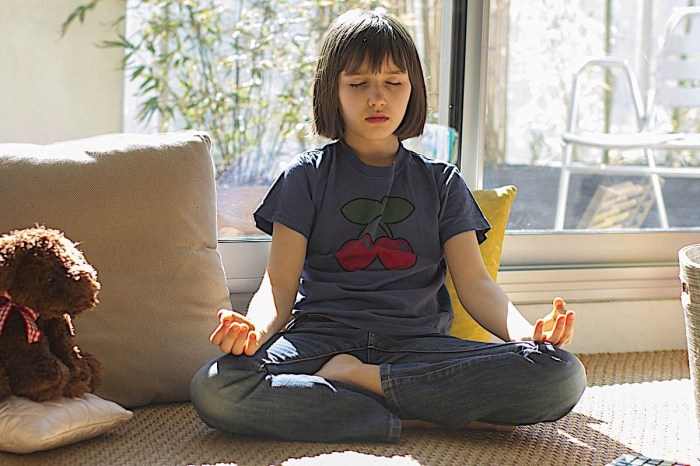30 Little Children’s Meditation Practices for Teaching Gratitude takes center stage, inviting you into a world of mindfulness designed specifically for kids, where gratitude is the ultimate superpower. Get ready to explore a unique blend of meditation and gratitude practices that will uplift young minds and nurture their spirits.
In a world filled with distractions, these practices offer a path to inner peace and positivity, empowering children to navigate life with grace and gratitude. Dive into this transformative journey and watch as little ones bloom with gratitude and joy.
Introduction to Children’s Meditation Practices

Teaching meditation practices to children is crucial in today’s fast-paced world. As kids navigate through school, extracurricular activities, and social pressures, meditation can provide them with tools to manage stress and cultivate a sense of inner peace.
Meditation has been shown to benefit children’s emotional well-being by helping them develop skills such as mindfulness, focus, and self-regulation. By incorporating meditation into their daily routine, children can learn to navigate their emotions more effectively and develop a greater sense of self-awareness.
Help your little ones relax their bodies with these 15 Quick Little Children’s Meditation Routines to Relax the Body. A relaxed body leads to a relaxed mind!
Benefits of Incorporating Gratitude into Children’s Meditation Practices
- Gratitude helps children cultivate a positive mindset and shift their focus from what they lack to what they have. This can lead to increased happiness and contentment.
- By practicing gratitude during meditation, children can learn to appreciate the little things in life and develop a sense of perspective. This can help them overcome challenges and setbacks with resilience and optimism.
- Teaching children to express gratitude for themselves and others can promote empathy, kindness, and a sense of connection within their communities. This can foster a supportive and inclusive environment for children to thrive and grow.
Overview of Gratitude in Children’s Meditation

Gratitude plays a crucial role in children’s meditation practices as it fosters a positive mindset and emotional well-being. By teaching children to cultivate gratitude, they can learn to appreciate the good things in their lives, develop empathy, and build resilience in the face of challenges.
After a busy day, children can unwind with these fun 12 Little Children’s Meditation Games to Relax After a Busy Day. Turn relaxation into a playful activity!
Definition of Gratitude in Children’s Meditation
Gratitude in children’s meditation refers to the practice of acknowledging and being thankful for the positive aspects of their lives, no matter how big or small. It involves teaching children to focus on the present moment and cultivate a sense of appreciation for what they have rather than what they lack.
Teaching children mindfulness can have a positive impact on their mental well-being. Try incorporating these 7 Simple Little Children’s Meditation Exercises for Mindfulness into their routine for a calmer mind.
Benefits of Cultivating Gratitude in Children
- Enhances positive emotions and reduces negative feelings such as envy or greed.
- Improves mental health by promoting optimism and reducing stress and anxiety.
- Strengthens relationships by encouraging kindness and empathy towards others.
- Builds resilience and coping skills, helping children navigate challenges with a positive outlook.
Incorporating Gratitude into Children’s Meditation Exercises
- Guided Visualization: Encourage children to imagine a happy memory and express gratitude for it.
- Gratitude Journal: Have children write or draw things they are grateful for each day.
- Gratitude Circle: Create a group activity where children share what they appreciate about each other.
- Thankful Breathing: Teach children to take deep breaths while focusing on things they are thankful for.
30 Little Children’s Meditation Practices for Teaching Gratitude

Incorporating meditation practices into children’s routines can help them develop a sense of gratitude and mindfulness. Here are 30 different meditation practices suitable for children that can aid in cultivating gratitude.
If you’re looking for ways to help your kids relax and unwind, check out these 10 Best Little Children’s Meditation Techniques for Happy Kids. These simple techniques can make a big difference in their daily lives.
1. Gratitude Journaling
- Have children write down three things they are grateful for each day.
- This practice helps children focus on the positive aspects of their lives, fostering gratitude.
- Encourage children to reflect on their entries regularly to reinforce feelings of gratitude.
2. Guided Imagery
- Lead children through visualizations of happy moments or things they are thankful for.
- This helps children connect with positive emotions and appreciate the good in their lives.
- Encourage children to engage their senses during these visualizations for a more immersive experience.
3. Mindful Breathing Exercises
- Teach children to focus on their breath as a way to calm their minds and bodies.
- By practicing mindful breathing, children can learn to appreciate the present moment and cultivate gratitude for their own existence.
- Encourage children to take deep breaths and pay attention to the sensations as they breathe in and out.
4. Loving-Kindness Meditation
- Guide children to send loving and kind thoughts to themselves and others.
- This practice fosters empathy and compassion, leading to a greater sense of gratitude towards others.
- Encourage children to include different people in their loving-kindness meditations, such as family, friends, and even those they may have conflicts with.
5. Nature Walk Meditation
- Take children on a nature walk and encourage them to observe and appreciate the beauty around them.
- This practice helps children connect with the natural world and develop gratitude for the environment.
- Encourage children to engage all their senses during the walk, from feeling the breeze to listening to the sounds of nature.
Age-Appropriate Meditation Techniques
When introducing children to meditation practices, it is crucial to tailor the techniques based on their age to ensure engagement and effectiveness. Younger children might have shorter attention spans and different cognitive abilities compared to older children, so adapting the practices is essential for their understanding and enjoyment.
Emotional control is an important skill for kids to learn. Try these 12 Little Children’s Meditation Exercises for Better Emotional Control to help them manage their emotions effectively.
Preschoolers (Ages 3-5)
- Guided Imagery: Use simple and colorful visualizations to help preschoolers focus and relax.
- Breathing Buddies: Encourage children to focus on their breath by using stuffed animals placed on their bellies to rise and fall with each breath.
- Affirmation Chants: Teach simple affirmations that children can repeat while sitting quietly or moving gently.
Elementary School Children (Ages 6-12)
- Body Scan Meditation: Guide children to focus on different parts of their body, relaxing each one progressively.
- Loving-Kindness Meditation: Encourage children to send positive thoughts and wishes to themselves and others.
- Mindful Coloring: Combine meditation with a creative activity like coloring to engage children in a calming practice.
Teens (Ages 13-18)
- Mindful Walking: Invite teens to practice mindfulness while walking, paying attention to each step and the sensations in their body.
- Gratitude Journaling: Encourage teens to write down things they are grateful for each day, fostering a sense of appreciation and mindfulness.
- Guided Meditation Apps: Introduce teens to meditation apps that offer guided practices tailored to their age group and interests.
Creating a Gratitude Meditation Routine for Children: 30 Little Children’s Meditation Practices For Teaching Gratitude

Establishing a structured gratitude meditation routine for children can help instill a sense of appreciation and mindfulness from an early age. Here are some steps to create an effective routine:
Frequency and Duration of Meditation Sessions
When it comes to children’s meditation practices, consistency is key. Aim for short, frequent sessions rather than long, sporadic ones. Consider starting with brief sessions and gradually increasing the duration as children become more comfortable with the practice.
- Start with 5-10 minute sessions and gradually increase to 15-20 minutes as children become more accustomed to meditation.
- Try to incorporate meditation into their daily routine, whether it’s in the morning before school or in the evening before bedtime.
- Encourage children to practice gratitude meditation at least 3-4 times a week to experience the benefits and develop a habit.
Maintaining Consistency and Engagement
Keeping children engaged and motivated in their meditation practice is essential for long-term success. Here are some tips to maintain consistency and engagement:
- Make meditation sessions fun and interactive by incorporating storytelling, guided imagery, or music to keep children interested.
- Encourage children to share what they are grateful for during each session to foster a sense of community and connection.
- Set realistic goals and celebrate small milestones to keep children motivated and engaged in their meditation practice.
Benefits of Gratitude Meditation for Children

Gratitude meditation can have numerous positive effects on children’s mental health and overall well-being. It helps them develop a sense of appreciation for the world around them and fosters a positive outlook on life. Here are some key benefits of gratitude meditation for children:
Enhanced Empathy and Compassion
- Gratitude practices encourage children to focus on the good things in their lives, which can help them become more empathetic towards others.
- By cultivating a sense of gratitude, children learn to appreciate the efforts and kindness of those around them, leading to increased compassion towards others.
- Research has shown that gratitude meditation can improve social relationships and enhance children’s ability to connect with and understand the feelings of others.
Positive Impact on Mental Health, 30 Little Children’s Meditation Practices for Teaching Gratitude
- Gratitude meditation can help children combat negative emotions such as anxiety, stress, and depression by shifting their focus towards positive experiences and feelings of gratitude.
- Practicing gratitude regularly can boost children’s self-esteem and confidence, promoting a healthier mindset and emotional well-being.
- Studies have indicated that children who engage in gratitude meditation show lower levels of aggression and higher levels of happiness and life satisfaction.
Improved Resilience and Emotional Regulation
- Gratitude practices teach children to find joy in simple moments and appreciate the present, which can build resilience and help them cope with challenges and setbacks.
- By fostering a grateful attitude, children develop better emotional regulation skills and are better equipped to handle stress and adversity.
- Practicing gratitude meditation can empower children to focus on solutions rather than problems, enabling them to navigate difficult situations with a positive mindset.
Embark on a journey of gratitude and mindfulness with 30 Little Children’s Meditation Practices for Teaching Gratitude. Let these practices be a guiding light for children, helping them cultivate a heart full of gratitude and a mind full of peace. Start your journey today and watch the magic unfold in the lives of the little ones around you.




